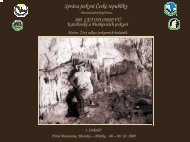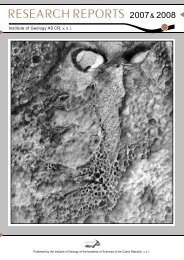triradiate locomotion Triadobatrachus evidenced segmentation
Get PDF (915K) - Wiley Online Library
Get PDF (915K) - Wiley Online Library
Create successful ePaper yourself
Turn your PDF publications into a flip-book with our unique Google optimized e-Paper software.
18 Development of the pelvic skeleton in frogs, H. RoCková and Z. RoCek<br />
As fossils documenting the temnospondyl–salientian<br />
transition are scarce, and because they can provide<br />
only limited information concerning the origin of the<br />
anuran pelvis, this incompleteness in the palaeontological<br />
record may be supplemented by data gained from<br />
developmental morphology. Developmental processes,<br />
if properly assessed, may provide a useful tool for<br />
explanation of evolutionary transformations. Therefore,<br />
we decided to study the development of the pelvis<br />
and associated structures in various modern anurans<br />
in order to recognize some general developmental patterns.<br />
We believe that this can help to complete information<br />
on the evolutionary transformation of the<br />
pelvis, which is now available only from comparison of<br />
the terminal developmental stages of adult temnospondyls<br />
and anurans.<br />
In order to interpret a developmental sequence<br />
correctly as an evolutionary one, it is necessary to<br />
discern which features of the development reflect the<br />
temnospondyl–salientian evolutionary transition and<br />
which are mere adaptations to a particular mode of<br />
anuran <strong>locomotion</strong>. Locomotion in anurans involves not<br />
only saltation (e.g. in Rana, Discoglossus), but also<br />
swimming (in permanent water-dwellers such as Pipidae,<br />
Palaeobatrachidae) and crawling (e.g. in Bufo). Burrowing<br />
(e.g. in Pelobates) is also a type of activity which<br />
is performed by the hind limbs.<br />
Therefore, we followed development of the pelvis<br />
and associated structures (sacrum, urostyle and iliosacral<br />
articulation) in each representative of the anuran<br />
locomotory types; we then tried to find coincidences<br />
between anatomical peculiarities and a particular locomotory<br />
type (although it is known that species with, for<br />
instance, the same ilio-sacral articulation morphology<br />
may show significant differences in types of movement;<br />
see Emerson, 1979), and finally we tried to<br />
deduce some anatomical and functional evolutionary<br />
sequences that occurred between temnospondyls and<br />
their anuran descendants.<br />
Materials and methods<br />
For our study we chose Discoglossus pictus and both<br />
European species of Bombina, which represent a lineage<br />
of the Discoglossidae, whose roots may be found<br />
among Middle Jurassic anurans (Evans et al. 1990). This<br />
lineage involves both aquatic/terrestrial (Discoglossus)<br />
as well as predominantly aquatic (Bombina) forms.<br />
Mostly terrestrial toads, which move by crawling rather<br />
than by saltation, are represented by Bufo bufo. A similar<br />
type, but capable of burrowing with the help of<br />
hind legs, is Pelobates fuscus. Terrestrial frogs with<br />
extremely well-developed saltatory <strong>locomotion</strong> are<br />
represented by Rana dalmatina. Permanent waterdwellers<br />
are represented by Xenopus laevis. Therefore,<br />
four principal locomotory types of frogs are represented<br />
– terrestrial saltatory, terrestrial crawler, terrestrial<br />
burrower and permanent water-dweller. To avoid<br />
duplicating their descriptions, we give a full description<br />
of the development of Discoglossus pictus, which may<br />
be considered phylogenetically the most promitive<br />
among them and, to a certain degree, a model species;<br />
descriptions of other species are restricted to differences<br />
from this model. Developmental series were<br />
obtained from laboratory breeding in the Department<br />
of Zoology, Charles University, Prague.<br />
Specimens used in this study were staged according<br />
to the normal table of X. laevis recognizable by external<br />
criteria (Nieuwkoop & Faber, 1967), although considerable<br />
variation exists in the appearance of internal<br />
characteristics (see discussion in RoCek, 2003). Clearing<br />
and staining of the whole mounts followed methods<br />
used by Wassersug (1976), with slight modifications of<br />
concentrations and timing. We investigated 27 cleared<br />
and stained specimens of X. laevis (stages 52–66), 130<br />
specimens of R. dalmatina (stages 47–66), 95 specimens<br />
of Bufo bufo (stages 50–66), 112 specimens of P. fuscus<br />
(stages 44–66), six specimens of D. pictus (stages 52–<br />
66), 72 specimens of Bombina bombina (stages 50–66)<br />
and 110 specimens of Bombina variegata (stages 50–<br />
66).<br />
Some stages of Discoglossus were also prepared as<br />
three-dimensional (3D) software reconstructions from<br />
histological sections, in order to investigate the muscular<br />
context of the pelvis. For this purpose we used 3D<br />
Studio MAX 5.0; smoothing was performed in Bone-<br />
Viewer, a program specially written for this purpose by<br />
Ysoft Co., Czech Republic.<br />
All the material is deposited in the Department of<br />
Zoology, Charles University, Prague.<br />
Results<br />
Discoglossus pictus<br />
The earliest structure of the pelvic girdle and associated<br />
parts of the vertebral column is a pair of neural<br />
arches of the sacral (i.e. 9th) vertebra, adjacent to the<br />
© Anatomical Society of Great Britain and Ireland 2005





